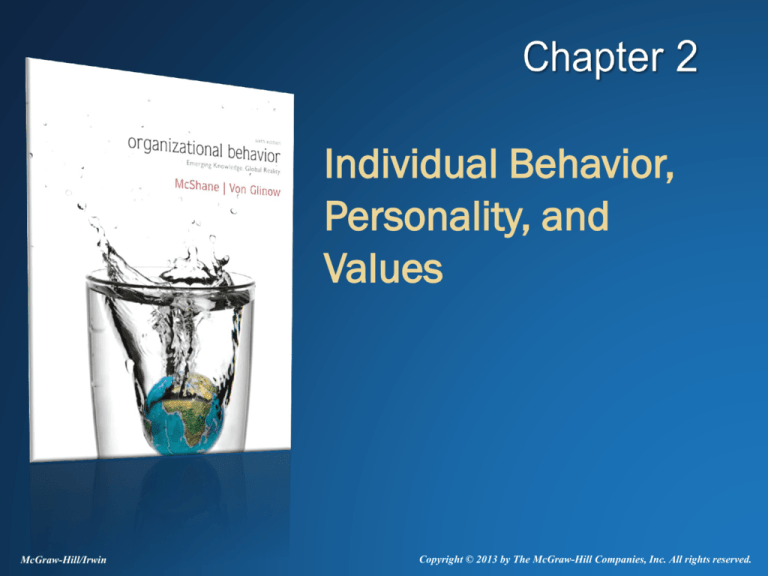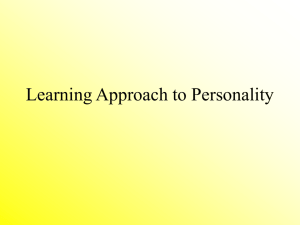
Individual Behavior,
Personality, and
Values
McGraw-Hill/Irwin
Copyright © 2013 by The McGraw-Hill Companies, Inc. All rights reserved.
Individual Behavior at OhioHealth
OhioHealth has weathered
economic recessions and
national skills shortages by
being an employer of choice for
job applicants, minimizing
absenteeism and turnover,
encouraging extra-role behavior,
and supporting high
performance.
2-2
MARS Model of Individual Behavior
Situational
factors
Personality
Motivation
Values
Self-concept
Perceptions
Ability
Emotions &
attitudes
Stress
Individual
behavior and
results
Role
perceptions
2-3
Employee Motivation
Internal forces that affect a person’s
voluntary choice of behavior
• direction
• intensity
• persistence
S
M
A
BAR
R
2-4
Employee Ability
Natural aptitudes and learned capabilities
required to successfully complete a task
Competencies - personal characteristics that
lead to superior performance
Person - job matching
• selecting
• developing
• redesigning
S
M
A
BAR
R
2-5
Role Perceptions
Beliefs about what behavior is required to
achieve the desired results:
• understanding what tasks to perform
• understanding priority of tasks
• understanding preferred behaviors
to accomplish tasks
S
M
A
BAR
R
2-6
Situational Factors
Environmental conditions beyond the
individual’s short-term control that constrain
or facilitate behavior
Constraints – time, budget, facilities, etc
Cues – e.g. signs of nearby hazards
S
M
A
BAR
R
2-7
Types of Individual Behavior
Task Performance
Organizational
Citizenship
Goal-directed behaviors under the
person’s control
Contextual performance – cooperation
and helpfulness beyond required job
duties
more
2-8
Types of Individual Behavior (con’t)
Counterproductive
Work Behaviors
Voluntary behaviors that potentially
harm the organization
Joining/staying with
the Organization
Agreeing to employment relationship;
remaining in that relationship
Maintaining Work
Attendance
Attending work at required times
2-9
Defining Personality
Relatively enduring pattern of thoughts,
emotions, and behaviors that characterize a
person, along with the psychological
processes behind those characteristics
• External traits – observable behaviors
• Internal states – thoughts, values, etc inferred from
behaviors
• Some variability, adjust to suit the situation
2-10
Nature vs. Nurture of Personality
Influenced by Nature
• Heredity explains about 50 percent of
behavioral tendencies and 30 percent
of temperament
• Minnesota studies – twins had similar
personalities
Influenced by Nurture
• Socialization, learning
• Personality stabilizes throughout
adolescence
• Executive function steers behavior
guided by our self-concept
2-11
Five-Factor Personality Model
(CANOE)
Conscientiousness
Organized, dependable
Agreeableness
Trusting, helpful, flexible
Neuroticism
Anxious, self-conscious
Openness to Experience
Creative, nonconforming
Extraversion
Outgoing, talkative, energetic
2-12
Five-Factor Personality and
Organizational Behavior
Conscientiousness and emotional stability
• Strongest personality predictors of performance
Extraversion
• Linked to sales and mgt performance
• Related to social interaction and persuasion
Agreeableness
• Effective in jobs requiring cooperation and helpfulness
Openness to experience
• Linked to higher creativity and adaptability to change
2-13
Jungian Personality Theory
Swiss psychiatrist Carl Jung
Identifies preferences for perceiving the
environment and obtaining/processing
information
Commonly measured by Myers-Briggs Type
Indicator (MBTI)
2-14
Jungian & Myers-Briggs Types
Extraversion (E)
•Talkative
•Externally-focused
•Assertive
Sensing (S)
•Concrete
•Realistic
•Practical
Thinking (T)
•Logical
•Objective
•Impersonal
Judging (J)
•Organized
•Schedule-oriented
•Closure-focus
Getting
energy
Perceiving
information
Making
decisions
Orienting to the
external world
Introversion (I)
•Quiet
•Internally-focused
•Abstract
Intuitive (N)
•Imaginative
•Future-focused
•Abstract
Feeling (F)
•Empathetic
•Caring
•Emotion-focused
Perceiving (P)
•Spontaneous
•Adaptable
•Opportunity-focus
2-15
Myers-Briggs Type Indicator (MBTI)
Extroversion versus introversion
• similar to five-factor dimension
Perceiving information
• Sensing – uses senses, factual, quantitative
• Intuition – uses insight, subjective experience
Judging (making decisions)
• Thinking – rational logic, systematic data collection
• Feeling – influenced by emotions, how choices affect
others
Orientation toward the external world
• Perceiving – flexible, spontaneous, keeps options open
• Judging – order and structure
2-16
Values in the Workplace
Stable, evaluative beliefs that guide our
preferences
Define right or wrong, good or bad
Value system -- hierarchy of value
2-17
Schwartz’s Values Model
2-18
Schwartz’s Values Model
Openness to change – motivation
to pursue innovative ways
Conservation -- motivation to
preserve the status quo
Self-enhancement -- motivated by
self-interest
Self-transcendence -- motivation to
promote welfare of others and
nature
2-19
Values and Behavior
Habitual behavior usually consistent with
values, but conscious behavior less so
because values are abstract constructs
Decisions and behavior are linked to values
when:
1. Have logical reasons to apply values in that
situation
2. Situation allows/encourages values enactment
3. Mindful of our values
2-20
In Search of Congruent Values
Scott Reed (far right) and his siblings joined the Chick-filA restaurant chain because its strong family values were
compatible with their personal values. “Chick-fil-A’s core
values line up well with mine,” says Reed.
.
2-21
In Search of Congruent Values
Similarity of a person’s values hierarchy to another
source
Person-organization value congruence
Espoused-enacted value congruence
Organization-community values congruence
2-22
Three Ethical Principles
Utilitarianism
Individual
Rights
Distributive
Justice
Greatest good for the greatest number
of people
Fundamental entitlements
in society
People who are similar should receive
similar benefits
2-23
Influences on Ethical Conduct
Moral intensity
• degree that issue demands ethical principles
Ethical sensitivity
• ability to recognize the presence and determine the
relative importance of an ethical issue
Situational influences
• competitive pressures and other external factors
Mindfulness
• actively evaluate whether action violates values
2-24
Supporting Ethical Behavior
Ethical code of conduct
Ethics training
Ethics hotlines
Ethical leadership and shared values
2-25
Cross-Cultural Values at Infosys
Infosys Technologies, one of
India’s largest technology
companies, anticipated crosscultural differences when it
acquired an Australian company.
Infosys held seminars where
employees from both countries
learned about their cultures and
discussed how they can manage
employees with these different
values.
2-26
Individualism
High Individualism
USA
Italy
India
The degree to which people
value personal freedom, selfsufficiency, control over
themselves, being appreciated
for unique qualities
Denmark
Taiwan
Low Individualism
2-27
Collectivism
High Collectivism
Italy
Taiwan
The degree to which people
value their group membership
and harmonious relationships
within the group
India
Denmark
USA
Low Collectivism
2-28
Power Distance
High Power Distance
Malaysia
• Value obedience to authority
Venezuela
• Comfortable receiving
commands from superiors
• Prefer formal rules and authority
to resolve conflicts
Japan
USA
Denmark
Israel
Low Power Distance
High power distance
Low power distance
• expect relatively equal power
sharing
• view relationship with boss as
interdependence, not
dependence
2-29
Uncertainty Avoidance
High U. A.
Greece
Japan
• feel threatened by ambiguity
and uncertainty
• value structured situations and
direct communication
Italy
USA
High uncertainty avoidance
Low uncertainty avoidance
• tolerate ambiguity and
uncertainty
Singapore
Low U. A.
2-30
Achievement-Nurturing
Achievement
Japan
High achievement
orientation
• assertiveness
• competitiveness
China
USA
France
Chile
• materialism
High nurturing orientation
• relationships
• others’ well-being
Sweden
Nurturing
2-31
Cultural Diversity within the
United States
Increasing surface-level diversity
• Also associated with some deep-level diversity
(e.g. racial differences in individualism)
Regional differences in deep-level diversity
• e.g. openness to experience, neuroticism,
collectivism
• Regional variations likely caused by:
- local institutions (schools, religion)
- physical environment
- migration
2-32
Individual Behavior,
Personality, and
Values








